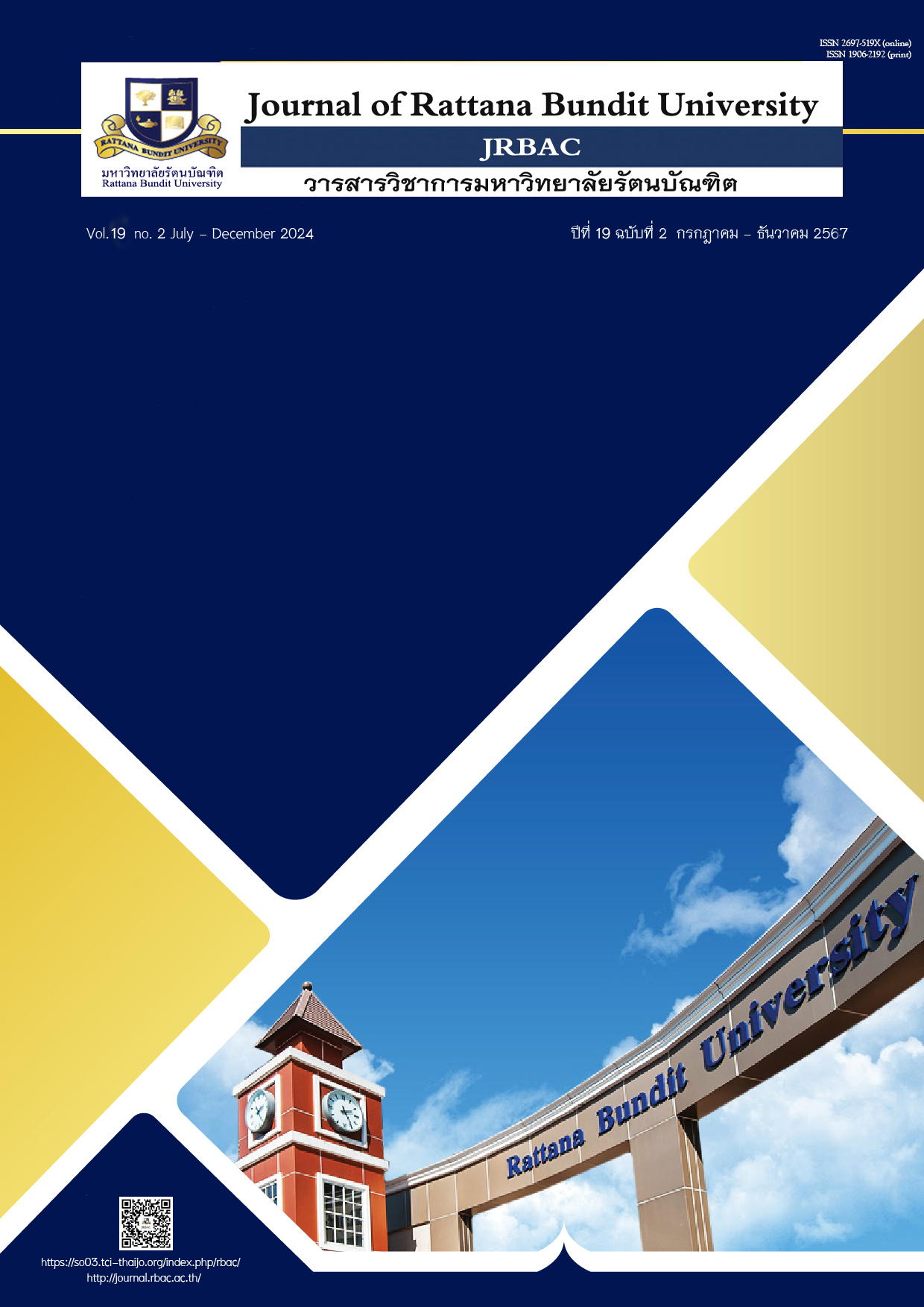A Study on Cybercrime Fear among Government Personnel During the COVID-19 Pandemic
Main Article Content
Abstract
The COVID-19 pandemic has altered crime patterns and statistics from previous norms, with many individuals becoming victims of new forms of crime. This research aims to examine the level of fear of cybercrime and the factors associated with fear of crime among government personnel during the COVID-19 outbreak. Data were collected from a sample of 401 government employees, selected using the sample size indicated in the table for determining sample size from a given population. Questionnaires were used as the primary data collection tool. Data analysis employed descriptive statistics—such as percentages, frequencies, means, and standard deviations—and inferential statistics, including t-tests and F-tests. The findings revealed that the sample group had a low overall level of fear of crime during the COVID-19 pandemic. When comparing levels of fear across personal factors, such as age, health status, affiliation with agencies under the Ministry of Justice, and average monthly income, it was observed that different approaches to managing crime victims impacted the level of fear of crime. The results of this study can inform policy development on crime prevention and public safety to reduce fear of crime.
Article Details

This work is licensed under a Creative Commons Attribution-NonCommercial-NoDerivatives 4.0 International License.
References
ตำรวจภูธรภาค 9. (2567, กรกฎาคม 29). สถิติเหยื่ออาชญากรรมไซเบอร์. สำนักงานตำรวจแห่งชาติ. https://www.police9.go.th/ตร-เผย-สถิติเหยื่ออาชญา/
Provincial Police Region9. (2024, July 29). Cybercrime victim statistics. Royal Thai Police Office. https://www.police9.go.th/ตร-เผย-สถิติเหยื่ออาชญา/ (in Thai)
ธิติรัตน์ สมบูรณ์. (2566, ตุลาคม 25). รู้ เข้าใจและตระหนัก อาชญากรรมทางไซเบอร์ (Cybercrime) ป้องกันภัยคุกคามใกล้ตัว. มหาวิทยาลัยจุฬาลงกรณ์. https://www.chula.ac.th/news/138291/
Somboon, T. (2023, October 25). Know, understand and realize cybercrime protects against imminent threats. Chulalongkorn University. https://www.chula.ac.th/news/138291/ (in Thai)
ปณิศา เอมโอชา. (2567, กุมภาพันธ์ 24). แฮกเกอร์ประกาศขายข้อมูลคนไทยเกือบ 20 ล้านชุดข้อมูลในเดือน ม.ค. 67 หน่วยงานรัฐโดนด้วย 2 แห่ง. บีบีซีไทย. https://www.bbc.com/thai/articles/cgl435v8evno
Amocha, P. (2024, February 24). Hackers announced the sale of nearly 20 million data sets of Thai people in January 2024. Two government agencies were also affected. BBCThai. https://www.bbc.com/thai/articles/cgl435v8evno (in Thai).
ปริญญา หอมเอนก. (2563, มิถุนายน 23). ผู้เชี่ยวชาญ มั่นใจ ชีวิตวิถีใหม่ อยู่ภายใต้ภัยคุกคามทางไซเบอร์. สถาบันเพื่อการยุติธรรมแห่งประเทศไทย. https://www.tijthailand.org/highlight/detail/detail/cybercrime-covid-19
Homanak, P. (2020, June 23). Experts are confident in the new way of life, under cyber threats. The Office of Justice Affair. https://www.tijthailand.org/highlight/detail/detail/cybercrime-covid-19 (in Thai).
ปวันตา บุญพันธ์. (2558). ความรู้สึกหวาดกลัวอาชญากรรมของผู้สูงอายุในเขตลาดพร้าว กรุงเทพมหานคร. วารสารสหวิทยาการ วิทยาลัยสหวิทยาการ, 12(2), 8-11. https://so06.tci-thaijo.org/index.php/citujournal/ article/view/246741/167481
Boonphant, P. (2015). A study on the fear of crime among: The elderly in Lad Phrao Bangkok. Journal of Integrated Sciences, 12(2), 8-11. https://so06.tci-thaijo.org/index.php/citujournal/article/view /246741/167481 (in Thai)
พระราชกำหนดการบริหารราชการในสถานการณ์ฉุกเฉิน พ.ศ. 2548. (2548, กรกฎาคม, 16). ราชกิจจานุเบกษา, 122(58ก). https://ratchakitcha.soc.go.th/documents/166932.pdf
Emergency Decree on Public Administration in Emergency Situation, B.E. 2548. (2005, July 16). The Government Gazette, 122(58a). https://ratchakitcha.soc.go.th/documents/166932.pdf (in Thai)
เศรษฐศักดิ์ กตัญญู. (2565). ความหวาดกลัวอาชญากรรมในมหาวิทยาลัย. วารสารวิชาการและนวัตกรรมทางสังคมศาสตร์, 4(2), 3-4. https://so07.tci-thaijo.org/index.php/JAIS/article/view/1838/1266
Katanyu, S. (2022). Fear of crime in university. Journal of Academic and Innovation in Social, 4(2), 3-4. https://so07.tci-thaijo.org/index.php/JAIS/article/view/1838/1266 (in Thai)
สุดารักษ์ สุวรรณานนท์. (2563, กันยายน 9). การศึกษาความหวาดกลัวอาชญากรรมในประเทศไทย. สถาบันเพื่อการยุติธรรมแห่งประเทศไทย. https://www.tijthailand.org/article/detail/fear-of-crime-in-thailand
Suwannanon, S. (2017, September 9). Sustainable development goals. The Office of Justice Affair. https://www.oja.go.th/sdgs16/ (in Thai)
สำนักงานพัฒนาธุรกรรมทางอิเล็กทรอนิกส์. (2564, เมษายน 9). การสำรวจพฤติกรรมผู้ใช้อินเทอร์เน็ตในประเทศไทย ปี 2563. https://www.etda.or.th/th/newsevents/pr-news/ETDA-released-IUB-2020.aspx
สำนักงานตำรวจแห่งชาติ. (2566, ธันวาคม 21). สถิติคดีอาญาคดีความผิดเกี่ยวกับชีวิต ร่างกาย และเพศ จำแนกตามประเภทความผิด รายจังหวัด พ.ศ. 2560-2565. สำนักงานสถิติแห่งชาติ. https://www.nso.go.th/nsoweb/nso/ statistics_and_indicators?impt_branch=310
Royal Thai Police. (2023, December 21). Statistics of criminal cases against life, body and sex classified by type of offense by province 2017-2022. National Statistical Office. https://www.nso.go.th/nsoweb/ nso/statistics_and_indicators?impt_branch=310 (in Thai)
สำนักงานพัฒนาธุรกรรมทางอิเล็กทรอนิกส์. (2564, เมษายน 9). การสำรวจพฤติกรรมผู้ใช้อินเทอร์เน็ตในประเทศไทย ปี 2563. https://www.etda.or.th/th/newsevents/pr-news/ETDA-released-IUB-2020.aspx
Electronic Transactions Development Agency. (2021, April 9). Thailand internet user behavior 2020. https://www.etda.or.th/th/Useful-Resource/publications/Thailand-Internet-User-Behavior-2020.aspx (in Thai)
อรวินท์ เซ่งไพเราะ. (2565, กุมภาพันธ์ 24). สถิติการเกิดอาชญากรรม พ.ศ. 2564. สำนักงานตำรวจแห่งชาติ. http://thaicrimes.org/pdf/crimes/calendar2564.pdf
Sengphairo, O. (2021, February 24). Crime statistics 2020. Royal Thai Police Office. http://thaicrimes.org/ pdf/crimes/calendar2564.pdf (in Thai)
Council of Europe. (2020). Cybercrime and COVID-19. http://www.coe.int/web/cybercrime/cybercrime-and-covid-19
Global Initiative. (2020, March 26). Crime and contagion: The impact of a pandemic on organized crime. https://globalinitiative.net/analysis/crime-contagion-impact-covid-crime/
Meyer, M., Hassafy, A., Lewis, G., Shrestha, P., Haviland, A. M., & Nagin, D. S. (2022). Changes in crime rates during the COVID-19 Pandemic. Statistics and Public Policy, 9(1), 97–109. https://doi.org/10.1080/2330443X.2022.2071369


